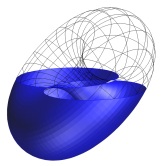A torus can be generated by rotating a circle around an axis in the same
plane as the circle, but not intersecting it. We can produce parametric
equations for such a torus of revolution as follows: if we consider a
circle of radius b in the xz-plane, centered at the point
(x, z) = (a, 0) on the x-axis, then
the points on the circle are given by
(x, z) =
(a + b cos ,
b sin
).
If we rotate this circle about the z-axis, then each point
(x, z) on the original circle traces out a new circle in a
plane parallel to the xy-plane; the radius of this new circle
will be x (the distance of the original point from the
z-axis), and the height of the plane containing the new circle
will be z. This means the new circle can be parameterized by
(x cos
,
x sin
,
z).
As we let (x, y) vary over the entire original circle, we
obtain a parameterization for the torus:
T(,
) =
((a + b cos
)
cos
,
(a + b cos
)
sin
,
b sin
).

In "Torus Triptych" we used a = and b = 1. This
basic torus was rotated to three different positions and then sliced by
a horizontal plane at various heights to obtain the three sequences
presented. The lower sequence (in blue) has a particularly interesting
slice in the second image. Here, the horizontal plane intersects the
torus in two overlapping circles of equal radius.